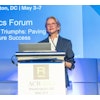Renal complications that occur during contrast-enhanced coronary angiography could be diminished through the use of iso-osmolar rather than low-osmolar contrast media. That’s the conclusion of one of two studies on the relationship between contrast media and nephrotoxicity featured this week in our X-Ray Digital Community.
In the first article, Swedish researchers compared the use of iodixanol, an iso-osmolar agent, with that of iohexol, a low-osmolar agent, in diabetic patients with elevated serum creatinine levels. The osmolality profile of the newer iodixanol agent is closer to that of blood than low-osmolar agents, and could potentially reduce the number of contrast-related reactions.
Three days after imaging, the patients who received iodixanol had a significantly smaller rise in creatinine levels than those who got iohexol. Only 3% of iodixanol patients had a rise of at least 0.5 mg/dL, compared with 26% of iohexol patients, according to the researchers.
A related study, on the use of low-osmolar agents in patients with moderate renal insufficiency, found that pretreating these patients with acetylcysteine prior to coronary angiography protects against nephrotoxicity. Patients treated with acetylcysteine were 68% less likely to experience a rise of more than 25% in serum creatinine levels within two days of contrast administration.
The authors of both studies said more research is needed on the subject. For example, it’s possible that the use of iodixanol alone could obviate the need for acetylcysteine due to the contrast agent’s safety profile among patients with renal insufficiency. For the rest of the story, go to x-ray.auntminnie.com.



















